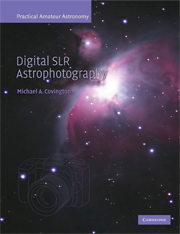A - Astrophotography with non-SLR-digital cameras
Published online by Cambridge University Press: 21 August 2009
Summary
If your digital camera is not a DSLR, it has a smaller sensor with a higher noise level, making it unsuitable for deep-sky work. More importantly, it doesn't have interchangeable lenses.
Those facts don't make it useless. Non-SLR digital cameras have one great advantage – their shutters are almost totally vibration-free. This enables them to get sharp images of the sun, moon, and planets (Figures A.1–A.3). In fact, a Nikon Coolpix 990 is my usual camera for photographing lunar eclipses.
The coupling of camera to telescope has to be afocal; that is, the camera is aimed into the telescope's eyepiece. Numerous adapters to hold the camera in place are available; my favorite, which only works with older Nikon cameras, is a ScopeTronix eyepiece that threads directly into the filter threads of the camera. With a bright image of the Moon, the camera can be hand-held.
Set the camera to infinity focus (the mountain symbol), turn off the flash, and focus the telescope while viewing the display on the camera. If the Moon fills the field, the camera can autoexpose; otherwise, you'll have to set the exposure manually by trial and error. Set the self-timer (delayed shutter release) so that the picture will not be taken until you have let go of the the camera and it has stopped vibrating.
The examples shown here are single images, but you can of course take many exposures of the same object and combine them with RegiStax (p. 206).
- Type
- Chapter
- Information
- Digital SLR Astrophotography , pp. 199 - 201Publisher: Cambridge University PressPrint publication year: 2007
- 5
- Cited by



